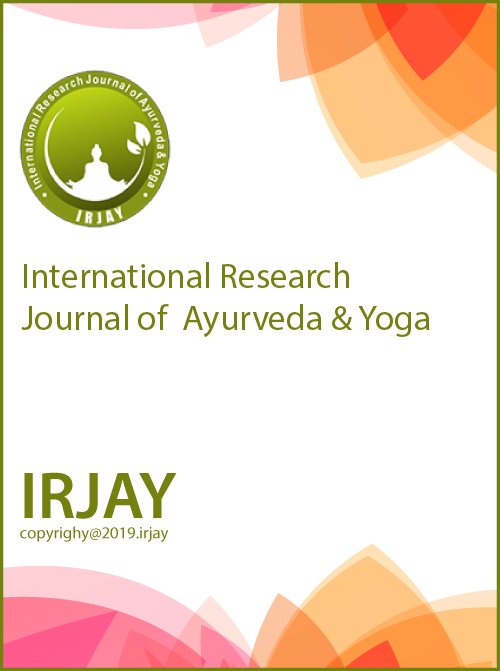Pharmacological action and Properties of Swasahara Mahakashaya in Swasa Roga: A Review.
DOI:
https://doi.org/10.48165/IRJAY.2023.6414Keywords:
Swasa, Swasahara, Mahakashaya, DyspnoeaAbstract
Swasa (Dyspnoea) is a Yapya vyadi (incurable but manageable) with Sthana Sanshraya (stage of localization) and Adhisthana (seat) as Pranavaha Srotas (respiratory channel). In modern medicine, it broadly involves lungs and heart as main site of pathology. They generally involve infective, allergic, genetic, occupational aetiology. So, the drug or group of drugs which act directly on Pranvaha Srotas, or on the disease will help in alleviation of disease. Charak mentioned these drugs as Swasahara Mahakashaya, a group of ten drugs which have direct action on the disease. This review will focus on establishing the action of these drugs on various conditions resulting in Dyspnoea as a prominent symptom. It will explore various causes of dyspnoea and factors responsible for dyspnoea, along with ayurvedic properties as well as pharmacological action of various active components of each individual drug on cellular level.
Downloads
References
Shastri KP, Charak Samhita Vidyotni Vyakhyan. Chikitsa Sthana 17/45-69, Varsanasi, Chaukhamba Bharti Academy, 2018.pp. 515-518.
Dev RR, Shabda Kapla Druma, Vol-5, 3rd ed, Chaukhambha Sanskrit series, Varanasi, 1967.pp 178. 3. Robertson C, Japp AG. Macleod’s Clinical Diagnosis. 2nd ed; Elsevier Ltd. 2018.
Jameson, Fauci, Kasper, Hauser, Longo, Loscalzo. Harrison’s Principle of Internal Medicine. 20th Edition; McGraw-Hill Education, 2018.
Shastri KP, Charak Samhita Vidyotni vyakhyan. Sutra Sthana 4/37,Varanasi, Chaukhamba Bharti Academy, 2018.pp. 60-61.
Rabb UN. Pharmacological Actions Of Shwasa Hara Dravyas (Anti Asthmatic/Bronchial Anti Spasmodics Drugs)-A Literary Review.
Kurde P. Role Of Shwasahara Mahakashaya In The Management Of Tamaka Shwasa With Respect To Bronchial Asthma-A Review Article. 2018 Jun;70(6):687- 712.
Rawat S,. Hedychium spicatum: a systematic review on traditional uses, phytochemistry, pharmacology and future prospectus. Journal of Pharmacy and Pharmacology. 2018 Jun;70(6):687-712.
Kimothi GP. Pushkarmool (Inula racemosa Hook. f.) a drug with potential bronchodilatory properties. info Ayurveda. 2014(2):20-2.
Ponnan A, Marudhamuthu M. Evaluation of anti inflammatory and analgesic effects of aqueous extract obtained from root powder of Inula racemosa Hook. f. Journal of Medicinal Plants Research. 2012 Apr 16;6(14):2801-6.
Vadnere GP, Gaud RS, Singhai AK, Somani RS. Effect of Inula racemosa root extract on various aspects of asthma. Pharmacologyonline. 2009;2:84-94.
Mudoi T, Deka DC, Devi R. In vitro antioxidant activity of Garcinia pedunculata, an indigenous fruit. In vitro. 2012 Jan;4(1):334-42.
Ali M, Paul S, Tanvir EM, Hossen M, Rumpa NE, Saha M, Bhoumik NC, Islam A, Hossain M, Alam N, Gan SH. Antihyperglycemic, antidiabetic, and antioxidant effects of Garcinia pedunculata in rats. Evidence-Based Complementary and Alternative Medicine. 2017 Oct 19;2017.
Kumar S, Kumari R. Traditional, Phytochemical and Biological activities of Elettaria cardamomum (L.) Maton—A review. Int. J. Pharm. Sci. Res. 2021;12:4122- 33.
Javaid R, Javed G, Ahmed F, Khan AA. HING (Ferula foetida Regel): A potent Unani Herb with its descriptive parameters of pharmacognosy and pharmacology: A Review. Journal of Drug Delivery and Therapeutics. 2020 Sep 15;10(5):362-7.
Ramgopal KV, Kumar CR. Critical review of herbs acting on pranavaha srotovikar. Int. J. Ayur. Pharma Research. 2013;1(3):19-26.
Mahendra P, Bisht S. Ferula asafoetida: Traditional uses and pharmacological activity. Pharmacognosy reviews. 2012 Jul;6(12):141.
Sultana A, Asma K, Rahman K, Rahman S. Oleo-gum resin of Ferula asafoetida: A traditional culinary spice with versatile pharmacological activities. Research Journal of Recent Sciences.
Alam J, Mujahid M, Rahman MA, Akhtar J, Khalid M, Jahan Y, Basit A, Khan A, Shawwal M, Iqbal SS. An insight of pharmacognostic study and phytopharmacology
of Aquilaria agallocha. Journal of Applied Pharmaceutical Science. 2015 Aug 28;5(8):173-81.
Chitre T, Bhutada P, Nandakumar K, Somani R, Miniyar P, Mundhada Y, Gore S, Jain K. Analgesic and anti inflammatory activity of heartwood of Aquilaria agallocha in laboratory animals. Pharmacol Online. 2007 May 22;1:288-98.
Rahman H, Vakati K, Eswaraiah MC. In-vivo and in-vitro anti-inflammatory activity of Aquilaria agallocha oil. International Journal of Basic Medical Sciences and Pharmacy (IJBMSP). 2012 Jun 23;2(1).
Pandey G, Madhuri S. Pharmacological activities of Ocimum sanctum (tulsi): a review. Int J Pharm Sci Rev Res. 2010 Nov;5(1):61-6.
Lee NY, Khoo WK, Adnan MA, Mahalingam TP, Fernandez AR, Jeevaratnam K. The pharmacological potential of Phyllanthus niruri. Journal of pharmacy and pharmacology. 2016 Aug;68(8):953-69.
Tjandrawinata RR, Susanto LW, Nofiarny D. The use of Phyllanthus niruri L. as an immunomodulator for the treatment of infectious diseases in clinical settings. Asian Pacific Journal of Tropical Disease. 2017 Mar;7(3):132-40.
Lee NY, Khoo WK, Adnan MA, Mahalingam TP, Fernandez AR, Jeevaratnam K. The pharmacological potential of Phyllanthus niruri. Journal of pharmacy and pharmacology. 2016 Aug;68(8):953-69.
Natarajan V, Dhas AS. Phytochemical composition and in vitro antimicrobial, antioxidant activities of ethanolic extract of Leptadenia reticulata [W&A] leaves. Middle East J. Sci. Res. 2014;21:1698-705.
Bhat ZA, Kumar D, Shah MY. Angelica archangelica Linn. is an angel on earth for the treatment of diseases. International Journal of Nutrition, Pharmacology, Neurological Diseases. 2011 Jan 1;1(1):36.
Martinez-Pitre PJ, Sabbula BR, Cascella M. Restrictive Lung Disease. 2022 Jul 25. In: StatPearls [Internet]. Treasure Island (FL): StatPearls Publishing; 2022 Jan–. PMID: 32809715.

